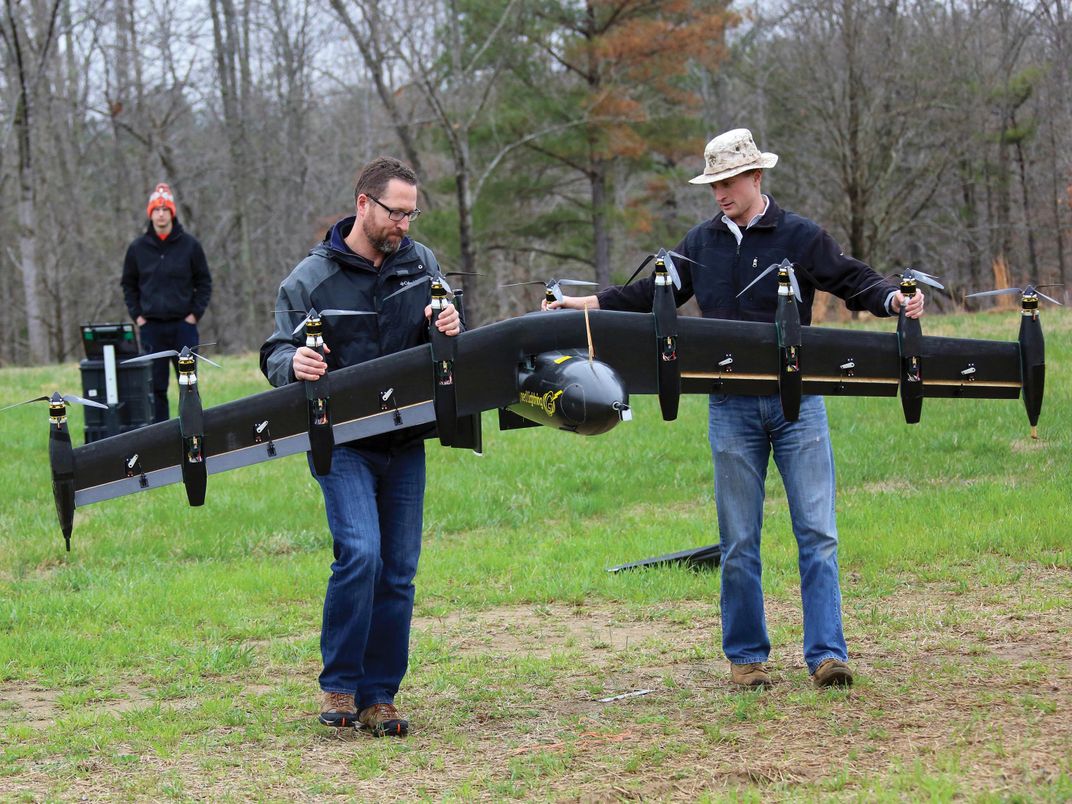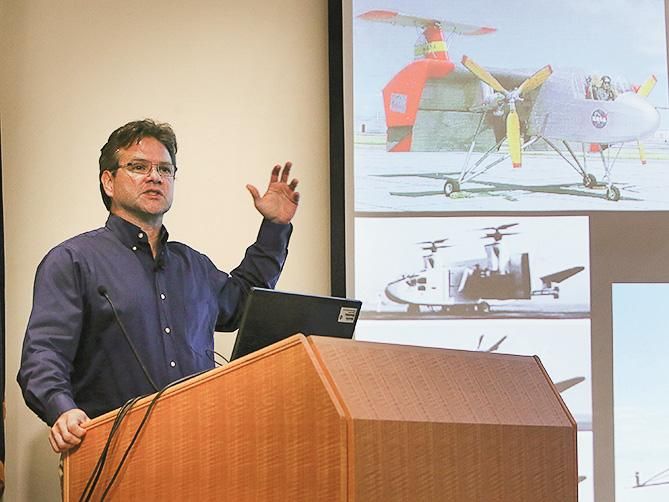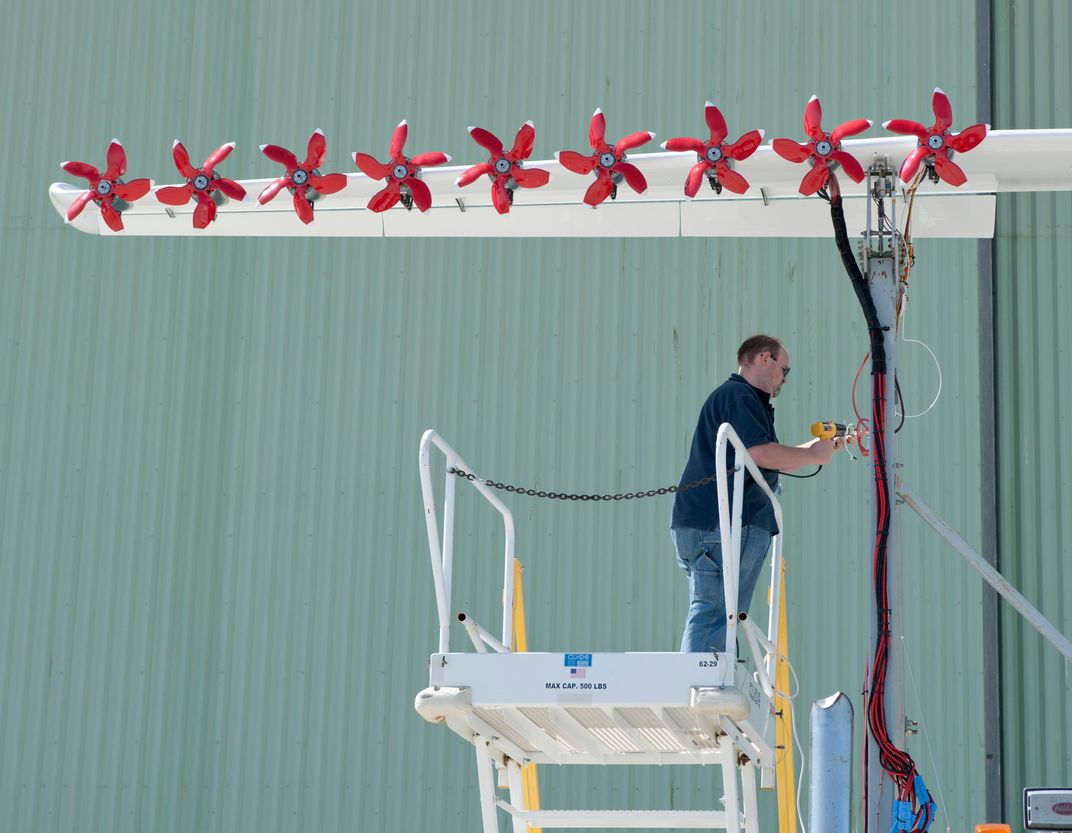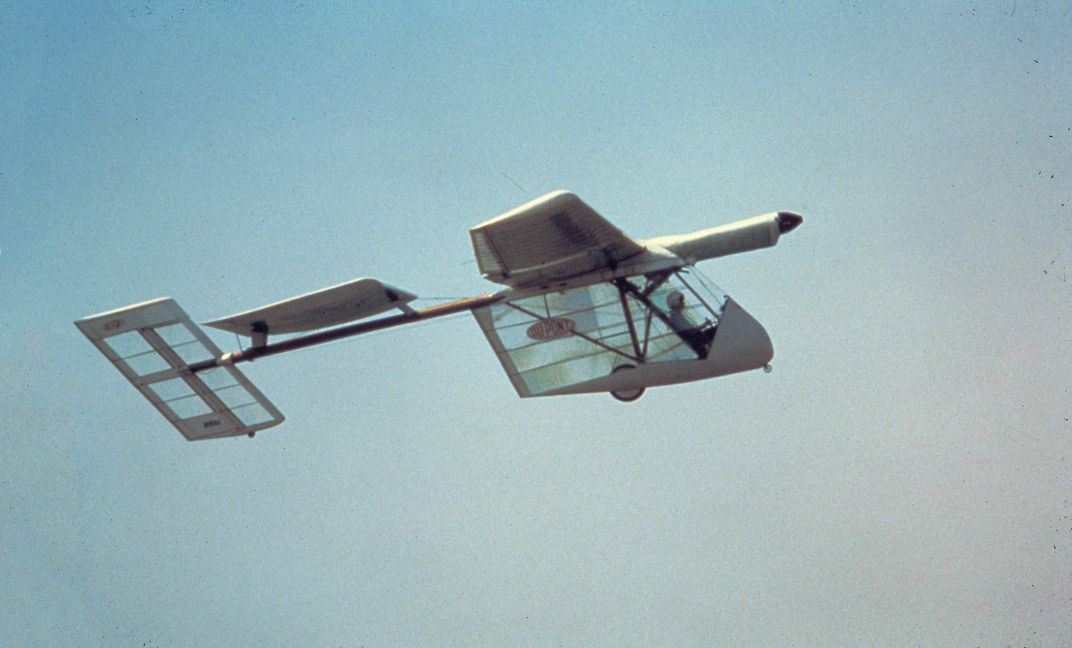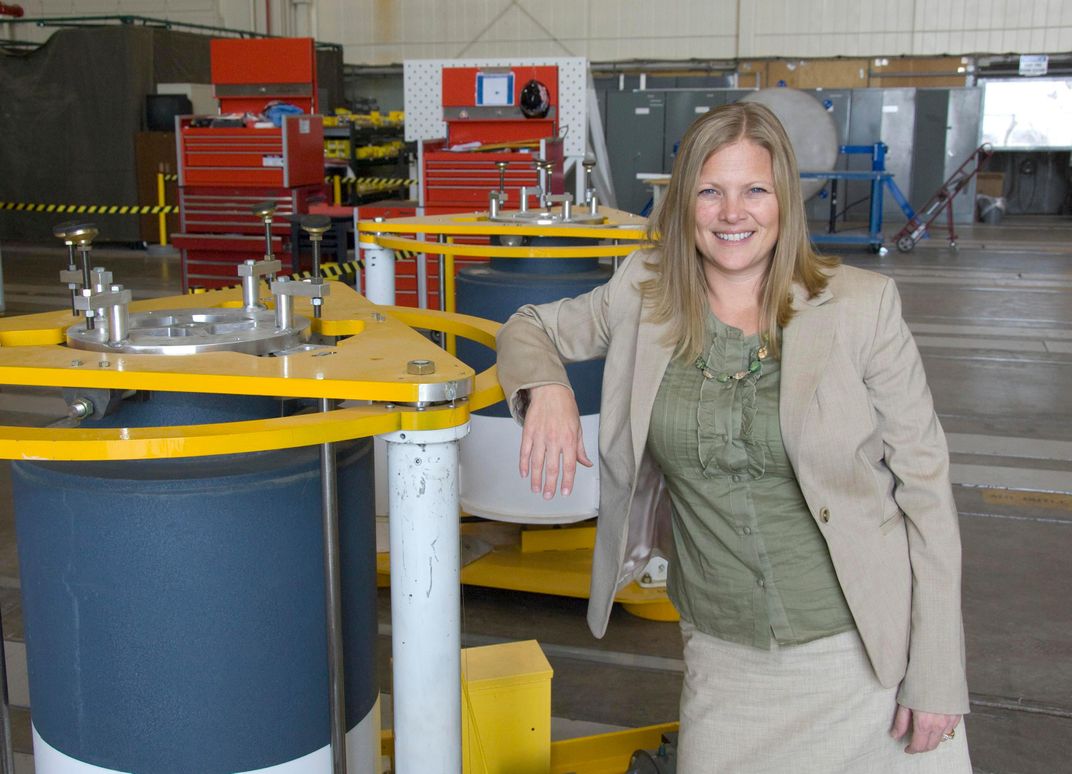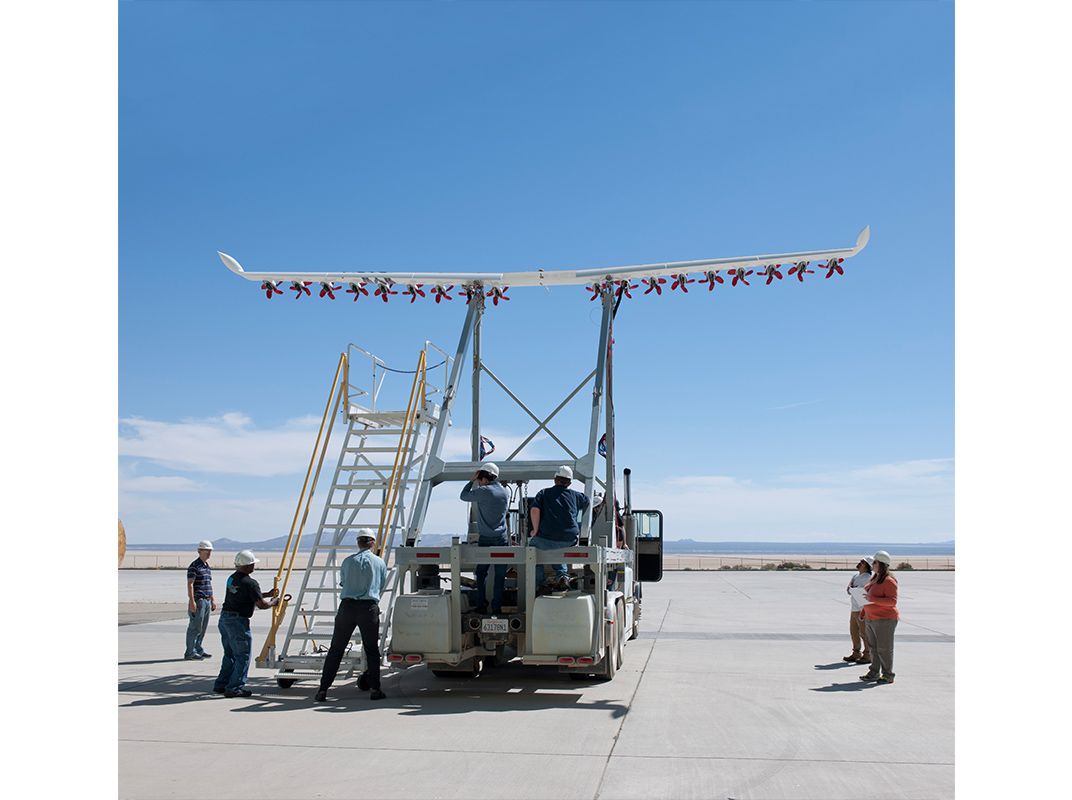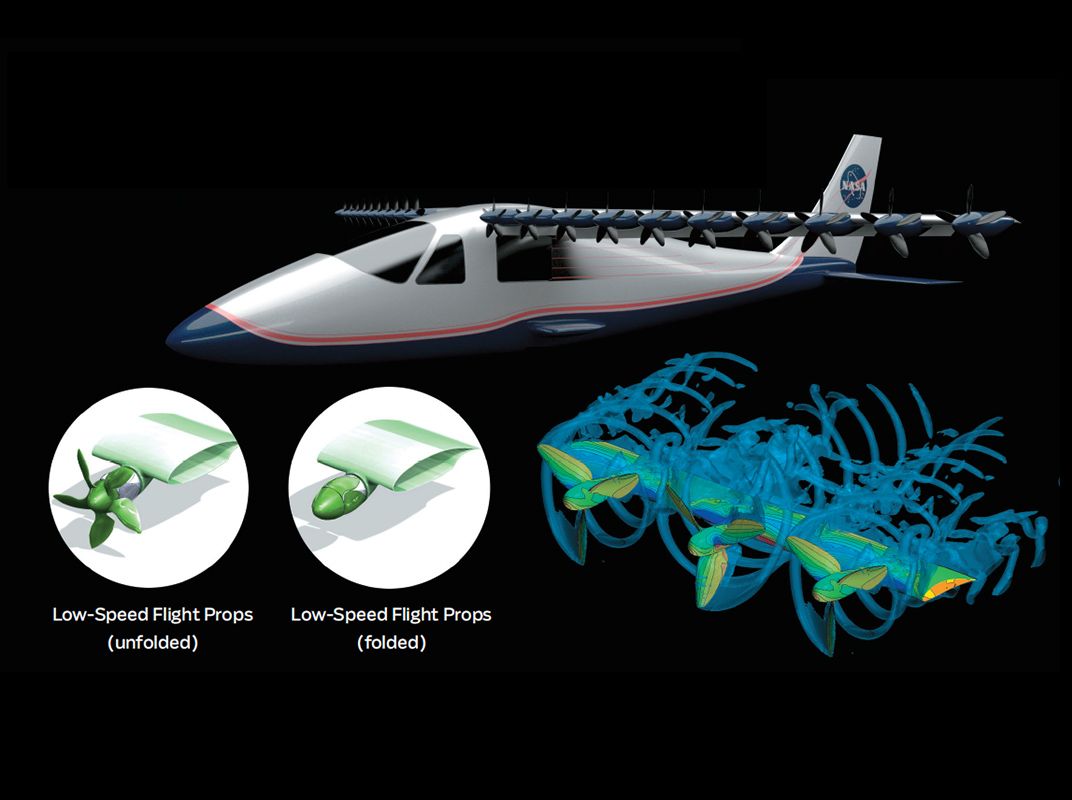Electrical Power Will Change the Look of Aviation
One propeller? Two? Try a dozen.
/https://tf-cmsv2-smithsonianmag-media.s3.amazonaws.com/filer/ca/9f/ca9f2c83-63fd-4909-9c4a-ec31ae610822/10b_dj2016_greasedlightningprototypea_live-web-resize.jpg)
It’s only a matter of when. We will exhaust Earth’s storehouse of petroleum…someday. Total reserves are estimated at between one and two trillion barrels, and at current rates, that could last, according to some sources through 2100 or so. Or the planet could heat up to a point where carbon-based fuels are no longer viable and we’d be forced to use alternative sources of energy. We humans have never been very good at planning for the distant future, so designing airplanes for a time when the only source of energy for propulsion is electricity seems like a science fair project. NASA is working on the problem, just in case. And it turns out that when you go electric, you just might get a better airplane.
A paper presented to the 2008 International Powered Lift Conference, an industry gathering focused on all things that take off vertically, described a hybrid wing-body aircraft (a fat aerodynamically shaped lift-producing fuselage with a wing) powered by two turbine engines driving a pair of super-efficient generators. The electric current produced by the generators would be distributed to motors that would power 16 fans about three feet in diameter. That was just an idea in a technical paper at one conference, but it didn’t go away.
In 2010, a far-flung group of NASA researchers were thinking about the future of American transportation, especially for short-distance, intra-metro travel, the trips that people usually make with their cars: in a word, the commute. Flying in the open sky is potentially much faster than driving, and because it seemed logical for short flights, the NASA people headed straight toward electric propulsion. (Batteries are excellent for short trips, but simply cannot hold enough energy to comfortably power longer flights.) Most current projects to develop electric light airplanes begin simply by removing the gasoline engine and replacing it with an electric motor. Not these guys.
As soon as the NASA team got started, they realized that an all-electric airplane should look very different from the light airplane conventionally configured with a big engine in the nose driving a single propeller. Instead of a single 300-horsepower flat six burning gasoline, they envisioned, say, 12 electric motors at 25 horsepower apiece. The NASA folks also realized from the beginning that, assuming an economical source of electrical power for recharging, a battery-powered light airplane could be very cheap to operate.
The NASA study lead, aerospace engineer Mark Moore at NASA’s Langley Research Center in Virginia, outlined in a paper (along with numerous co-authors) a system that would employ a fleet of vehicles with two advanced technologies: autonomous operation and electric propulsion. An electrically powered flight demonstrator called the GL-10 (GL stood for Greased Lightning) employed for vertical takeoff a tilt wing and horizontal stabilizer. The wing had eight electrically powered propellers, and the horizontal tail had two for balance and pitch control.
The autonomy component of that project—the technology to operate on internal programming alone, without a pilot’s guidance—is alive and well in the field of unmanned aerial systems (UASs). But the further development of the electric airplane is now fully in the hands of a sprawling team of people whose cell phones and email accounts are very busy, and they will be for the duration of a three-year, $15 million project. As Moore put it in an email, “This is an incredible opportunity, and an incredible responsibility.”
Although we don’t often think about it, electric motors offer real advantages to aircraft. Unlike internal combustion engines, they don’t need air to produce power, so they can maintain their full rated punch even at high altitudes, where the air is thin. And unlike internal combustion engines, with their drag-inducing requirements for cooling air, combustion air intake, fuel lines, and provision for exhaust gases, they can be mounted in airframes in different ways. With an electric motor, just run a couple wires to it and you’re done. Plus you can stick it anywhere. Electric motors can be made quite light and small and still develop considerable power with high reliability—they scale well. Air-breathing engines, both reciprocating and turbine, have many more moving parts, are more complex.
The limiting factor for an electric-powered aircraft is the battery. But NASA’s current program is not aimed at battery development, which is hugely complex, expensive, risky, and largely outside NASA’s areas of interest. Batteries are heavy, and their energy storage capacity increases only at an average of eight percent or so a year , so the less weight-sensitive automotive community has taken the lead in that endeavor (and is doing a bang-up job, by the way). The 2011 study to rethink transportation over limited distances calls its solution Zip Aviation, after the Zipcars concept, in which urban subscribers share a fleet of cars, essentially a timeshare for automobiles. Zip users place an electronic reservation, receive a confirmation along with the location of the nearest available car, and use special Zip keys to operate it.
NASA’s GL-10 established the configuration for future electric aircraft with its 10 motors spread around on every available leading edge, arrayed like birds on a powerline. In 2014, NASA teamed with two small think-tank-style technology companies in California: Empirical Systems Aerospace (ESAero) in Pismo Beach and Joby Aviation in Santa Cruz. An earlier NASA collaboration with Joby had produced the Lotus, an all-electric UAS with a set of two-blade rotors at each wingtip and one hinged propeller on the leading edge of the vertical tail. The current three-year project, known as SCEPTOR (for Scalable Convergent Electric Propulsion Technology Operations Research), will proceed in four phases and is designed around an existing modern lightplane design: the Tecnam P2006T. The high-wing, twin-engine aircraft is produced in Capua, Italy, and affords the NASA program an ideal platform to measure the gains, if any, from the electric propulsion system, which the team calls LEAPTech (Leading Edge Asynchronous Propeller Technology). First the researchers will fly and measure the existing airplane, then compare the data to measurements of the LEAPTech version. In November 2014, a facsimile of the concept vehicle’s wing mounted on a truck bed for dynamic testing of its low-speed lift systems arrived at NASA’s Armstrong center in California. The acronym department came up with HEIST, for Hybrid Electric Integrated Systems Testbed. The Peterbilt truck provides a platform that can test the towering contraption at the speeds typical of landing and takeoff.
Starr Ginn is Armstrong’s chief engineer for aeronautics research, and in an email she distills the purpose of HEIST: “The big question was how to enable affordable flight test and show how electric propulsion could have a great benefit on the environment and enable new aircraft configurations that hadn’t been possible with turbine engines. Our seedling idea was to use an old approach to studying low speed aero [by mounting the test article] on top of a truck.” It would have been easier to build another scaled-down UAS, she writes, but “I wanted to push the size of the test article so we could jump right into a manned airplane for a phase II effort with high confidence in the electric propulsion system.” So the wing on the truck is basically the wing that in a year or so will go on the flight test aircraft.
The leading edge of the current 31-foot carbon-fiber wing is festooned with 18 small electrically driven fans. Their small, chubby blades are not especially efficient, but they’re not meant to be. Their job is to provide a steady flow of air across the airfoil to produce lift, at the same time providing some thrust as well. Batteries containing lithium iron phosphate provide the juice (but might not for SCEPTOR—the exact battery model hasn’t yet been selected). Alex Stoll, an aeronautical engineer at Joby Aviation, says that what you don’t see on HEIST are the cruise motors, which are intended to be mounted on the wingtips in the final aircraft. In that position, the propellers will be immersed in the wingtip vortex, which will increase their efficiency. “Right now we’re looking at the wing during takeoff and landing, the effect of blowing air across the wing and thereby increasing lift,” Stoll says. “The high-lift [leading edge] propellers are all used during takeoff…. Once you get to a comfortable margin, say 30 percent above stall speed, then it will just run off the cruise [wingtip] props and you can fold the [blades on the] lift propellers.”
The next iteration of the lift propellers envisions five blades, all contoured to fold inward and fit snugly against the prop shaft recesses in their extended hubs. “In general, you see more blades because it’s quieter,” Stoll says. “The reason we chose five blades is because we want a smooth contour when it folds.” A current three-blade fan won’t work, he says. “A pentagon is closer to a circle than a triangle is. Initially we thought three blades would be more economical, but five blades has performance and noise benefits as well.”
The propeller tips are a little too close together for comfort. “That’s actually why we swept the wing [leading edge],” Stoll says. That staggers the planes of the propeller blades so they could actually overlap a bit. The design will evolve as the engineers learn from it. “Obviously the pilot won’t have 20 [thrust levers], and we’re trying to find the most failure-tolerant, reliable motor control system, determining failure modes and finding the optimum configuration for the pilot,” says Stoll. In other words, they’re looking at how to split control over so many motors between pilot and machine by thinking about how the machine could fail. The wing will be startlingly small and much lighter than a conventional wing because it can be sized for cruise flight. A normal wing is a compromise: It has to have enough area to produce lift down to the 61-knot (70-mph) stall speed required for light aircraft. At cruise, all that additional area becomes drag.
The electric wing can generate lift at a forward speed of zero because the lift motors blow air over it. Whereas normal wing loading would be about 17 pounds per square foot of area, the electric wing will come in at about 45 pounds per square foot because it has a much smaller area. As a result, the more highly loaded wing will be less sensitive to gusts and thus provide a smoother ride. The goals are ambitious: Operating the Tecnam P2006T with distributed electric propulsion will require one-third to one-fifth the energy needed to operate it with a conventional power supply, and total operating cost will be 30 percent less. Total life cycle emissions are to be reduced to a fifth of those of a conventional gasoline burner, based on current average U.S. electricity generation numbers. (The power plants making the electricity are the only emitters.) In the bargain, the noise drops from 85 decibels to around 70, which is just a little louder than your vacuum cleaner.
Electric propulsion for transport, whether from rechargeable batteries, fuel cells, or solar energy, is not the new part of LEAPTech. The Solar Challenger, a Paul MacCready design powered by solar panels driving an electric motor, flew 163 miles from France to England in 1981. In July 2015, the E-Fan, an Airbus design with batteries, crossed the English Channel a lot faster, only to be upstaged by a hobbyist who had made a round trip hours earlier in an electrified mini-airplane called the Cri-Cri. And the solar-powered Solar Impulse 2 is flying in stages around the entire globe.
But the configuration of little fans along the wing is new. By early August, project team members reported good progress. Says scientist Nicholas Borer of the Langley center, “The early results that they’ve been able to distill show good agreement with our [computer] models.” So the team fully expects to meet its goals: reducing energy consumption, carbon emissions, and operating cost. The LEAPTech group is coping with the usual start-up glitches, including problems with the instrumentation, much of which is salvaged from other projects, and some cracking in the propellers. “We’ve continued to run them with a certain amount of cracking,” says Trevor Foster, ESAero’s vice president of operations. “And in fact, we’ve now run the propellers all the way to failure, and you begin to characterize that cracking and we know how long we can run them before failure becomes a concern.” The team also knows the shape of the wing will change: “Packaging all the instrumentation and the power cables into that high-aspect-ratio wing has become really difficult and has already informed the new design of the airplane,” says Starr Ginn. The chord of the wing, the distance of a straight line drawn from the wing’s leading edge to its trailing edge, will increase, so the aspect ratio, which is the ratio of span to chord, will decrease. The number of inboard motors will decrease from 16 to 12, with slightly larger propellers making up for the loss. “I think we’re at the stage now where we’ve really converged on a strong solution,” Borer adds.
ESAero’s Trevor Foster says problems that crop up now are actually helpful. “Everything we’ve done in the first phase doesn’t have to go perfect. In fact, when something doesn’t go perfect, you learn more from that than when it does. It kinda [means] that failure is an option. We need that to happen so that we do learn something and we can carry that through these follow-on phases.” Ginn adds: “You’d hate to discover [problems] when you try to…get up in the air.”
Buried in NASA’s aims and goals is perhaps the most ambitious idea of all: that the LEAPTech project will provide the Federal Aviation Administration with engineering criteria for the certification of future aircraft. “I believe that distributed electric propulsion is one of the biggest technology changes in aerospace since the invention of the turbine engine,” says Mark Moore. “Turbines, when they were introduced, were essentially laughed at by many because they thought it couldn’t replace the wonderful internal combustion engines that existed. [But] within 10 to 20 years they completely replaced that technology. I think we’re at that same kind of replacement of technology—that within 10 to 20 years, distributed electric propulsion will replace turbine engines on a small scale, then we’ll see it on a larger scale.” In the meantime, the 100-octane low-lead aviation gasoline that powers the vast majority of piston engines in the general aviation fleet is selling in the lower 48 for $5.38 to $5.57 a gallon, according to a price tracking website’s quotes in early October. For any working class private pilots struggling to pay for a couple of hours of flying on weekends in their 40-year-old Cessna Skyhawks, the funny-looking experimental with the pinwheels on the wing could become the technology that makes flying affordable.
